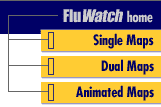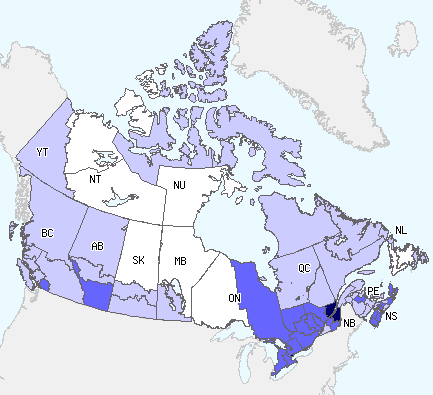Common menu bar links
E-mail this page
Fluwatch
Influenza detections continue to decline
During week 17, the overall rate of influenza detections continued to decline, however an increase in ILI consultations and outbreaks was reported. Two regions reported widespread influenza activity (in ON & QC). Localized influenza activity was reported by 16 regions, 8 regions reported no activity and 28 reported sporadic activity (see map). In week 17, the percentage of specimens that tested positive for influenza declined to 13.4% (562/4,209) for Canada (see table) though the proportion of influenza B detections increased from 53.6% in week 16 to 58.7% this week. To date this season, 58.7% of influenza detections in Canada were for influenza A viruses and 41.3% were for influenza B viruses. This week, the ILI consultation rate rose to 27 ILI consultations per 1,000 patient visits (see ILI graph), which is slightly above the expected range for this week. The sentinel response rate was 58%. Twenty four new outbreaks of influenza or ILI were reported this week as follows: 19 LTCFs, 2 schools and 3 in other institutions.
Antigenic Characterization:
The National Microbiology Laboratory (NML) has characterized 1,228 influenza viruses for the 2007-2008 influenza season: 454 (37%) A(H1N1), 196 (16%) A(H3N2) and 578 (47%) B viruses. Of the 454 influenza A(H1N1) viruses characterized, 433 (95.3%) were antigenically similar to A/Solomon Islands/3/2006 and 21 (4.6%) were antigenically similar to A/Brisbane/59/2007. Of the 196 influenza A(H3N2) viruses characterized, 9 (5%) were antigenically similar to A/Wisconsin/67/2005 and 187 (95%) were antigenically similar to A/Brisbane/10/2007. One of the 9 A/Wisconsin-like viruses had reduced titer to A/Wisconsin/67/2005 reference antiserum. Of the 578 influenza B isolates characterized, 14 (2%) were antigenically similar to B/Malaysia/2506/2004 and 564 (98%) were antigenically similar to B/Florida/4/2006 (belonging to the B/Yamagata lineage)(see pie chart).
***The WHO recommends that the vaccines to be used in the 2008-2009 season (northern hemisphere) contain the following: an A/Brisbane/59/2007 (H1N1)-like virus; an A/Brisbane/10/2007 (H3N2)-like virus; and a B/Florida/4/2006-like virus.
Antiviral Resistance:
Since the start of the season, the NML has tested 883 influenza A isolates (532 H1N1 and 351 H3N2) for amantadine resistance and found that 349 (99%) of the 351 H3N2 isolates were resistant to amantadine and 6 (1%) of 532 H1N1 isolates were resistant (see recommendation from the 2006-2007 influenza season below).
The NML has also tested 1,143 influenza isolates (462 A/H1N1, 171 A/H3N2 & 510 B) for oseltamivir (Tamiflu) resistance and found that 115 (25%) of the 460 H1N1 isolates tested were resistant to oseltamivir. The resistant isolates were from NL, NS, NB, QC, ON, MB, AB and BC. Of the 115 resistant viruses, 111 were A/Solomon Islands/3/06/-like and 4 were A/Brisbane/59/07-like. These oseltamivir resistant strains remain sensitive to the antiviral amantadine.
Influenza-associated Paediatric Hospitalizations:
In week 17, there were 17 new laboratory-confirmed influenza-associated paediatric hospitalizations reported through the Immunization Monitoring Program Active (IMPACT) network from ON, QC, and NS of which 12 (71%) were due to influenza A. Of the 433 hospitalizations reported so far this season, 64% (277/433) have been due to influenza A. The proportion of cases to date by age group are as follows: 22% were 0-5 month olds; 25% were 6-23 month olds; 23% were 2-4 year-olds; 21% were 5-9 year-olds; and 10% were 10-16 year-olds. Since the start of the season, 1 influenza-associated pediatric death has been reported to PHAC.
International:
CDC: During week 16, influenza activity continued to decrease in the United States with most influenza indicators having decreased from the previous week. Since September 30, 2007, CDC antigenically characterized 660 influenza viruses: 330 influenza A(H1) (220 A/Solomon Islands/3/2006-like, 20 showed somewhat reduced titers with antisera produced against A/Solomon Islands, and 90 were A/Brisbane/59/2007-like), 161 influenza A(H3) (35 A/Wisconsin/67/2005-like, 115 A/Brisbane/10/2007-like and 11 showed somewhat reduced titers with antisera produced against A/Wisconsin and A/Brisbane), and 169 influenza B viruses (8 belonging to the B/Victoria and 161 B/Yamagata lineage). Small numbers of influenza viruses resistant to oseltamivir have been detected in the United States, representing 7.3% (87/1,195) of all influenza viruses tested (10.4% among H1N1 viruses tested). To date, CDC has received a total of 68 reports of influenza-associated pediatric deaths that occurred this season.
EISS: Seasonal influenza activity is now back to levels seen outside the winter period in all European countries. Influenza virus type B accounted for 80% of the total positive specimens collected in week 16/2008. However, the majority of virus detections since the start of the season have been influenza A(H1N1) viruses. In most countries, influenza activity only reached moderate levels of intensity this winter. As of 23 April 2008, A(H1N1) viruses resistant to oseltamivir have been found in 19 countries in Europe with an overall prevalence of 23% (586/2533).
Human Avian Influenza: On April 30th 2008, the WHO reported an additional fatal case of H5N1 avian influenza infection in a 3-year old boy from Indonesia. The child developed symptoms on 14 April, was hospitalized on 21 April and died on 23 April. Investigations into the source of his infection indicate exposure to sick and dead poultry.
Recommendation for the Use of Amantadine for Treatment and Prevention of Influenza
The Public Health Agency of Canada does not recommend the use of amantadine for treatment or prevention of influenza for the 2006-2007 season. This recommendation will be revisited if new information becomes available.
Total number of influenza tests performed and number of positive tests by province/territory of testing laboratory, Canada, 2007-2008
| Province
of reporting laboratories |
Report
Period: April 20, 2008 to April 26, 2008 |
Season
to Date: August 26, 2007 to April 26, 2008 |
||||||
| Total
# Influenza Tests |
# of Positive Tests | Total
# Influenza Tests |
# of Positive Tests | |||||
| Influenza A | Influenza B | Total | Influenza A | Influenza B | Total | |||
| NL | 40 | 2 | 5 | 7 | 1169 | 71 | 129 | 200 |
| PE | 6 | 0 | 5 | 5 | 144 | 2 | 24 | 26 |
| NS | 62 | 13 | 5 | 18 | 945 | 106 | 89 | 195 |
| NB | 89 | 4 | 10 | 14 | 1273 | 106 | 173 | 279 |
| QC | 1240 | 58 | 105 | 163 | 27360 | 2145 | 1018 | 3163 |
| ON | 1614 | 103 | 176 | 279 | 31705 | 2306 | 1521 | 3827 |
| MB | 74 | 2 | 4 | 6 | 2653 | 82 | 37 | 119 |
| SK | 133 | 5 | 2 | 7 | 5685 | 343 | 278 | 621 |
| AB | 863 | 27 | 12 | 39 | 28160 | 899 | 922 | 1821 |
| BC | 88 | 16 | 8 | 24 | 3435 | 563 | 464 | 1027 |
| Canada | 4209 | 230 | 332 | 562 | 102529 | 6623 | 4655 | 11278 |
Specimens from NT, YT, and NU are sent to reference laboratories in other provinces.
Note: Cumulative data includes updates to previous weeks; due to reporting delays, the sum of weekly report totals do not add up to cumulative totals.
Abbreviations: Newfoundland/Labrador (NL), Prince Edward Island (PE), New Brunswick (NB), Nova Scotia (NS), Quebec (QC), Ontario (ON), Manitoba (MB), Saskatchewan (SK), Alberta (AB), British Columbia (BC), Yukon (YT), Northwest Territories (NT), Nunavut (NU)
Respiratory virus laboratory detections in Canada, by geographic
regions, are available weekly on the following website:
<http://www.phac-aspc.gc.ca/bid-bmi/dsd-dsm/rvdi-divr/index-eng.php>
Number of influenza surveillance regions† reporting widespread or localized influenza activity, Canada, by report week, 2007-2008 (N=54)
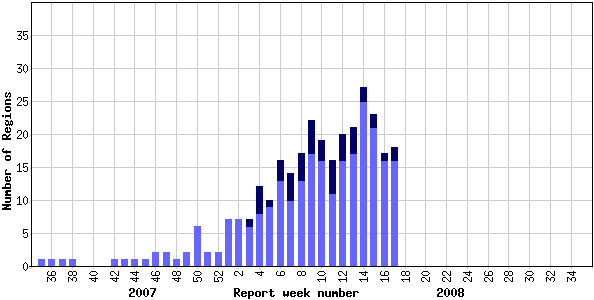
![]()
† sub-regions within the province or territory as defined by the provincial/territorial epidemiologist. Graph may change as late returns come in.
Influenza
Activity Level by Provincial and Territorial |
||||||||||||
|
||||||||||||
Note: Influenza activity levels, as represented on this map, are assigned and reported by Provincial and Territorial Ministries of Health, based on laboratory confirmations, sentinel ILI rates (see graphs and tables) and outbreaks. Please refer to detailed definitions. For areas where no data is reported, late reports from these provinces and territories will appear on the FluWatch website. Select single maps by report week to get this updated information.
<http://dsol-smed.phac-aspc.gc.ca/dsol-smed/fluwatch/fluwatch.phtml?lang=e>
Click on the map to view provinces/territories and maps for other weeks.
Influenza tests reported and percentage of tests positive, Canada, by report week, 2007-2008
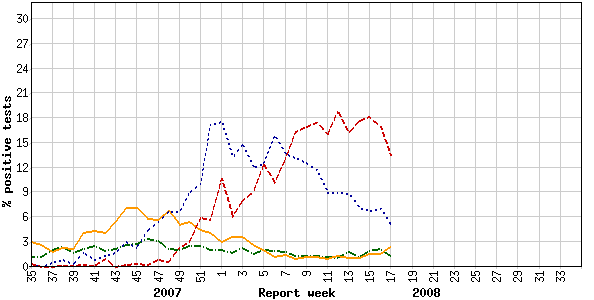
Percent positive influenza tests, compared to other respiratory viruses, Canada, by reporting week, 2007-2008
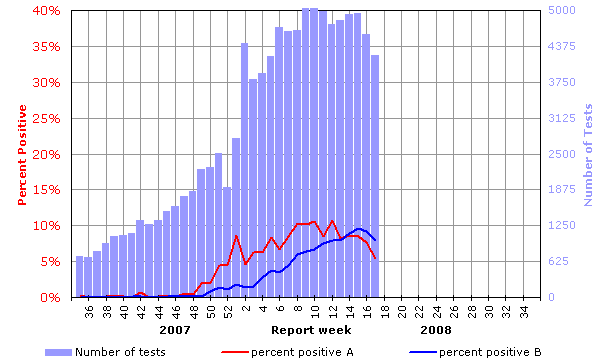
![]()
Influenza strain characterization, Canada, cumulative, 2007-2008 influenza season by the Respiratory Viruses Section at the National Microbiology Laboratory
[N=1,228]

{Strain characterization, number identified, per cent of total number}
NACI recommends that the trivalent vaccine for the 2007-2008 season in Canada contain A/Solomon Islands/3/2006 (H1N1)-like virus; an A/Wisconsin/67/2005 (H3N2)-like virus; and a B/Malaysia/2506/2004-like virus.
Influenza-like illness (ILI) consultation rates, Canada, by report week, 2007-2008 compared to 1996/97 through to 2006/07 seasons

![]()
Note: No data available for mean rate in previous years for weeks 19 to 39 (1996-1997 through 2002-2003 seasons).
Number of New Outbreaks in Long Term Care Facilities, Canada, by Report Week, 2007-2008
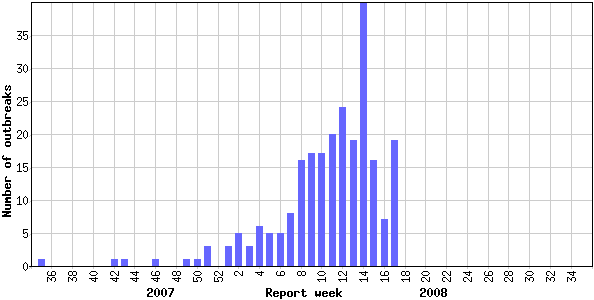
![]()
Please note that the above graphs may change as late returns come in.


